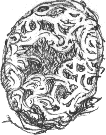 |
StrandlineThursday, 25th October 2001, West Yorkshire |
![]()
![]()
![]()
![]()
![]()
![]() This Month
Rocks
History
Workshop
Links
Home Page
This Month
Rocks
History
Workshop
Links
Home Page
![]()
Limpet

 The ribs on this Limpet are a clue to the environment in which it lived. The rule seems to be that the more heavily ribbed shells come from a high energy environment, smoother shells from calmer waters.
The ribs on this Limpet are a clue to the environment in which it lived. The rule seems to be that the more heavily ribbed shells come from a high energy environment, smoother shells from calmer waters.Scars on the inside of the shell show where its muscles were attached.
Tube-worm
 Tube-worms, probably Hydroides, have made their spaghetti like tubes of lime on this pebble. The worms feed by extending a fan of tentacles from the end of the tube.
Tube-worms, probably Hydroides, have made their spaghetti like tubes of lime on this pebble. The worms feed by extending a fan of tentacles from the end of the tube.Fossil Coral
 More spaghetti-like tubes, this time fossilised in limestone from the Carboniferous period, some 350 million years ago. It's a fossil coral called Lithostrotion that lived in root-like colonies. Corals build cups and platforms of lime.
More spaghetti-like tubes, this time fossilised in limestone from the Carboniferous period, some 350 million years ago. It's a fossil coral called Lithostrotion that lived in root-like colonies. Corals build cups and platforms of lime.Lava
 A geology teacher I know who lives on the Yorkshire coast would occasionally baffle his young students by saying; 'Today we're going to talk about amigdaloidal porphyritic andesite.'
A geology teacher I know who lives on the Yorkshire coast would occasionally baffle his young students by saying; 'Today we're going to talk about amigdaloidal porphyritic andesite.'Here's a specimen;
- Amygdaloidal refers to the almond-shaped cavities. They were originally spherical bubbles in volcanic lava but the holes have been squashed and infilled with another mineral.
- Porphyritic refers to a fine-grained texture with larger spots in it (originally referring to a purplish rock called porphyry which was quarried by the ancient Egyptians).
- Andesite is a kind of volcanic lava typical of continental collision zones similar to the one marked by the Andes today. I've no idea if this is andesite - it probably isn't - but it could well be lava. Snowdon, not far away from the beach where I picked this up, is built of layers of volcanic debris.
![]()
Richard Bell,
wildlife illustrator
E-mail; 'richard@willowisland.co.uk'
![]() Next page
Previous page
This day in 1999
This month
Nature Diary
Home Page
Next page
Previous page
This day in 1999
This month
Nature Diary
Home Page
![]()